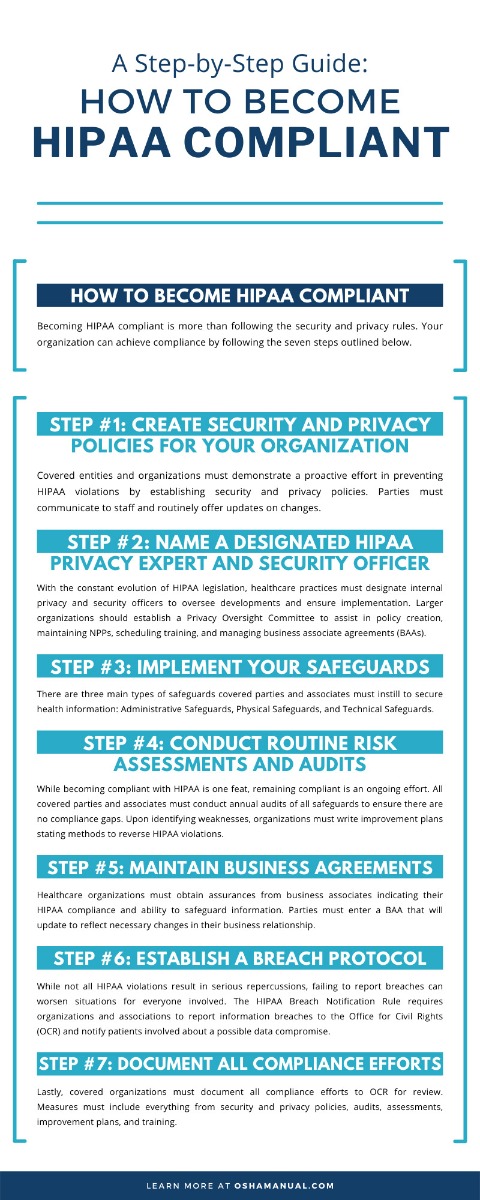
The Clinton Administration and other parties enacted the Health Insurance Portability and Accountability Act of 1996 (HIPAA) to reform healthcare record-keeping. Several of its main goals included the reduction of healthcare fraud and abuse, implementing standards concerning patient health information, and providing guaranteed safeguards for that sensitive data.
Carrying out HIPAA law is a significant daily responsibility for medical professionals, but how do healthcare organizations exercise the privacy rule efficiently? Here’s a step-by-step guide on how to become HIPAA compliant.
Importance of HIPAA for Healthcare
In 1996, the HIPAA privacy law primarily addressed the insurance coverage concern for individuals between jobs as part of its initial introduction. Without the act, many employees would face a coverage loss while switching from one job to another.
Today, most people associate HIPAA with its secondary goal, which was to ensure the utmost protection of all health information by restricting its access to authorized parties.
For Health Organizations
HIPAA helped reduce paperwork for health organizations and offered a smooth transition from hard copy record keeping to the electronic alternative. The change facilitated efficiency and streamlined administrative healthcare functions.
Electronic record-keeping also introduced consistency across the board, since all HIPAA-covered entities were required to use the same code sets and identifiers to safeguard information.
For Patients
For patients, HIPAA strived to hold healthcare practices accountable for safeguarding information, having them face repercussions when they failed to do so. With the many rules and security barriers, the law gave patients control and freedom to disclose health data to whoever they wanted.
Doing so encouraged patients to take on a more active role in their healthcare and even obtain copies of their data for their records. Having hard copies of their records allowed patients to check for errors and discrepancies and avoid repeated testing while seeking treatment from new providers.
How To Become HIPAA Compliant
Becoming HIPAA compliant is more than following the security and privacy rules. Your organization can achieve compliance by following the seven steps outlined below.
Step #1: Create Security and Privacy Policies for Your Organization
Covered entities and organizations must demonstrate a proactive effort in preventing HIPAA violations by establishing security and privacy policies. Parties must communicate to staff and routinely offer updates on changes.
Organizations must perform yearly orientations on HIPAA information and confirm complete understanding in writing. Healthcare organizations should distribute a Notice of Privacy Practices outlining policies, the handling of PHI, and their right to receive copies of medical records.
Step #2: Name a Designated HIPAA Privacy Expert and Security Officer
With the constant evolution of HIPAA legislation, healthcare practices must designate internal privacy and security officers to oversee developments and ensure implementation. Larger organizations should establish a Privacy Oversight Committee to assist in policy creation, maintaining NPPs, scheduling training, and managing business associate agreements (BAAs).
Also, having a HIPAA security officer ensures policies and procedures are in place to prevent and detect ePHI data breaches and conduct risk assessments.
Step #3: Implement Your Safeguards
There are three main types of safeguards covered parties and associates must instill to secure health information.
- Administrative Safeguards: Healthcare organizations must document security processes, establish their safety personnel, provide training, and adopt an information management system.
- Physical Safeguards: Covered entities must control who has access to physical facilities that contain sensitive information and secure all workstations.
- Technical Safeguards: Responsible parties must possess access controls that secure personal health information in databases exclusive to employees. The data must be under encryption when at rest or in transit.
Step #4: Conduct Routine Risk Assessments and Audits
While becoming compliant with HIPAA is one feat, remaining compliant is an ongoing effort. All covered parties and associates must conduct annual audits of all safeguards to ensure there are no compliance gaps.
Upon identifying weaknesses, organizations must write improvement plans stating methods to reverse HIPAA violations.
Step #5: Maintain Business Agreements
Healthcare organizations must obtain assurances from business associates indicating their HIPAA compliance and ability to safeguard information. Parties must enter a BAA that will update to reflect necessary changes in their business relationship.
Step #6: Establish a Breach Protocol
While not all HIPAA violations result in serious repercussions, failing to report breaches can worsen situations for everyone involved. The HIPAA Breach Notification Rule requires organizations and associations to report information breaches to the Office for Civil Rights (OCR) and notify patients involved about a possible data compromise.
Step #7: Document All Compliance Efforts
Lastly, covered organizations must document all compliance efforts to OCR for review. Measures must include everything from security and privacy policies, audits, assessments, improvement plans, and training.
Benefits of HIPAA Compliance
Whether you’re a managed service provider, a covered entity, or a business associate, remaining HIPAA compliant is beneficial to your business.
Trust
Organizations compliant with HIPAA present themselves as more trustworthy and dependable. Patients and clients will be confident in the services provided by the healthcare organization and will have their voices heard.
Loyalty
With trust comes loyalty that results in HIPAA-compliant organizations benefiting from increased patient and client traffic. When patients know they can trust a healthcare facility and its staff, they are more likely to continue using their services for their needs.
Profitability
The more patients and clients an organization can retain, the more profitability will increase. Retaining patients results in recurring revenue and a lesser need to seek new business.
Differentiation
Differentiating a business from its competition is vital! By staying HIPAA compliant, you can separate your organization from the rest as a distinguished location that prioritizes visitors' and clients' health, safety, and personal data.
Achieving HIPAA compliance is not an easy feat, especially for healthcare providers. As an obligatory responsibility, it’s up to providers and insurers to properly train and educate their staff on compliance. This step-by-step guide on how to become HIPAA compliant can help streamline requirement integration and organization so you can conduct business ethically.
For more information on online HIPAA compliance training, visit our Gamma Compliance Solutions web page catalog. We offer multiple educational resources on OSHA, HIPAA, and more for medical, dental, and veterinary providers.

